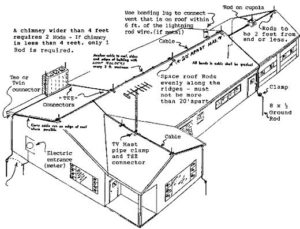This year 250 people in the United States will be killed by direct strikes of lightning. Another 500 will die in lightning caused fires. And at least 1500 persons will be injured by lightning which causes more damage, injuries and deaths each year than tornadoes, hurricanes or floods. The Lightning Protection Institute notes that 95% of today’s homes are not protected against lightning surges. Most of the deaths and injuries would not have occurred if proper lightning protection equipment was installed.
Lightning protection is designed for two objectives: it must provide a direct path for the lightning bolt to follow to ground, and it must prevent destruction or damage, injury or death, as it travels that path.







